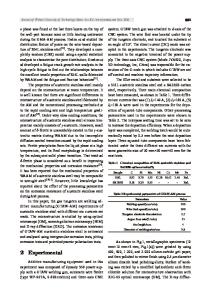An investigation on microstructure and pitting corrosion behavior of 316L stainless steel weld joint
- PDF / 846,368 Bytes
- 8 Pages / 584.957 x 782.986 pts Page_size
- 54 Downloads / 349 Views
Xinyuan Cao and Wei Wang National Center for Materials Service Safety, University of Science and Technology Beijing, Beijing 100083, China
Jiancang Zhaoa) Remanufacturing and Electric Power Safety Center, Suzhou Nuclear Power Research Institute Co. Ltd., Suzhou 215004, China
Yonghao Lu National Center for Materials Service Safety, University of Science and Technology Beijing, Beijing 100083, China
Tetsuo Shoji National Center for Materials Service Safety, University of Science and Technology Beijing, Beijing 100083, China; and Fracture and Reliability Research Institute, Tohoku University, Sendai 980-8579, Japan (Received 24 March 2017; accepted 16 June 2017)
Microstructure and pitting corrosion behavior of base metal (BM), heat-affected zone (HAZ), and weld zone (WZ) in the 316L stainless steel weld joint was investigated. The results indicated that WZ, including ferrite and austenite phases, was mainly composed of columnar dendrites, while BM and HAZ exhibited a full-austenite structure with low R coincidence site lattice boundaries especially twin boundary primarily. No obvious pitting occurred in WZ, while the millimeterscale pits were observed in HAZ and BM after immersion test in 6% FeCl3 solution. HAZ had a lower pitting potential than WZ and BM, while not much difference in pitting potential was observed between WZ and BM. Dendrite-selected corrosion occurred in WZ, while grain boundary was the preferable site for pitting corrosion in HAZ and BM. Gain refinement and a decrease in twin boundary volume fraction promoted the pitting corrosion susceptible of HAZ.
I. INTRODUCTION
Austenite stainless steel is widely used as the structural material in many fields for its outstanding mechanical and corrosion properties.1–4 Welding is extensively selected to connect these structural materials, and then the microstructure variation exists in the weld joint.5–7 It is believed that the microstructure discrepancy results in different local corrosion behavior such as pitting corrosion and intergranular corrosion and stress corrosion cracking during service.8–10 According to the previous works,1,11 the weld joint is mainly composed of weld zone (WZ), heat-affected zone (HAZ), and base metal (BM). Normally, it is accepted that WZ possesses a duplex structure including ferrite and austenite phases and the ferrite in the WZ reduces the hot cracking susceptible of the weld joint,1,7,11 while Kwok also found that the presence of ferrite in laser-welded
Contributing Editor: Jürgen Eckert a) Address all correspondence to this author. e-mail: [email protected] DOI: 10.1557/jmr.2017.316
s30400 stainless steel joint contributed to a decrease in pitting corrosion resistance.2 The HAZ, caused by thermal cycle during welding process, exhibits to be more susceptible to pitting corrosion compared with BM.1,11,12 Second phase precipitation, recrystallization, and residual stress are proposed as the accelerating factors for pitting corrosion resistance degradation of HAZ,3,11,12 and it is reported that HAZ is the most sensit
Data Loading...











